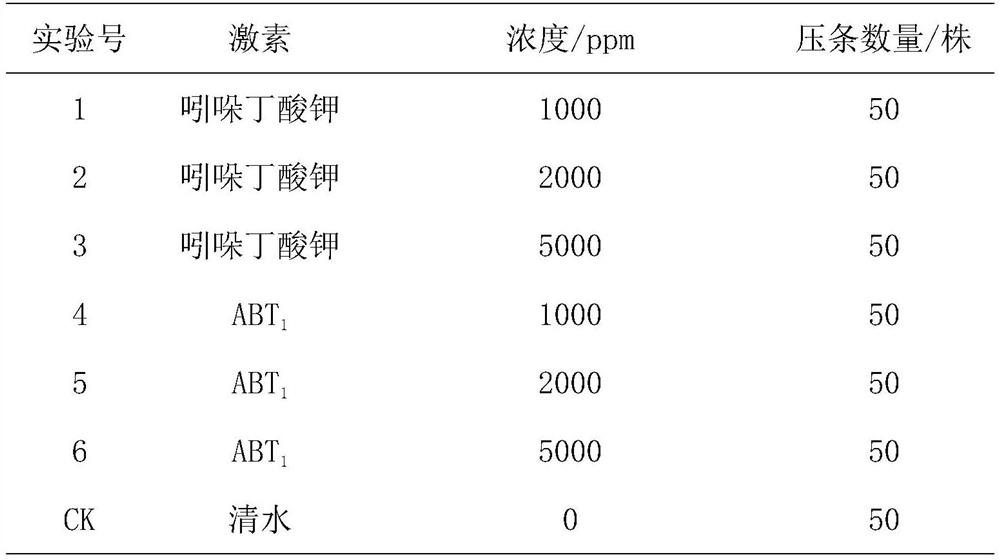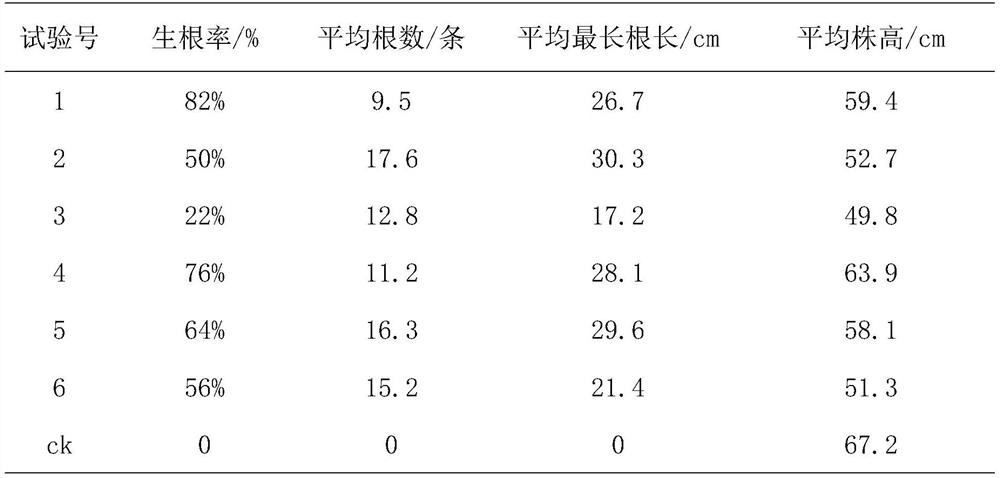Mongolian oak vegetative breeding method
A technology of mother plant and flat stubble, applied in the field of Quercus mongolica vegetative propagation, can solve the problems of difficult production and large-scale use, difficulty in rooting cuttings of Quercus mongolica, and low rooting rate, achieving high cost, low production cost, and high rooting rate Effect
- Summary
- Abstract
- Description
- Claims
- Application Information
AI Technical Summary
Problems solved by technology
Method used
Image
Examples
Embodiment 1
[0035] (1) Select sandy loam flat land, or slope land with a slope of less than 15°, close to water sources and unobstructed drainage as nursery land, and the planting density of mother plants is: row spacing 2m, plant spacing 1m;
[0036] (2) After the mother plant is planted, before it is frozen in November of the first year, the stubble is carried out close to the surface to promote the germination of the branches;
[0037] (3) Apply high-nitrogen compound fertilizer 25kg / mu from April to May;
[0038] (4) From the end of May to the first ten days of June, remove the weak and over-dense sprouting branches, keep the strong sprouting branches, and the horizontal spacing of the sprouting branches is greater than 3cm;
[0039] (5) Spray 300 times of potassium dihydrogen phosphate water-soluble fertilizer 5 days before layering;
[0040] (6) Remove the leaves within 15cm of the sprouting bar from the ground before binding and overflowing;
[0041] (7) Choose No. 24 iron wire w...
Embodiment 2
[0046] (1) Select sandy loam flat land, or slope land with a slope of less than 15°, close to water sources, and unobstructed drainage as nursery land. The planting density of mother plants is: row spacing 3m, plant spacing 0.3m;
[0047] (2) After the mother plant is planted, after thawing in the middle of March of the following year, the stubble is carried out close to the surface 5cm to promote the germination of the branches;
[0048] (3) Apply high-nitrogen compound fertilizer 50kg / mu from April to May;
[0049] (4) From the end of May to the first ten days of June, remove the weak and over-dense sprouting branches, keep the strong sprouting branches, and the horizontal spacing of the sprouting branches is greater than 3cm;
[0050] (5) Spray 600 times of potassium dihydrogen phosphate water-soluble fertilizer 7 days before layering;
[0051] (6) Remove the leaves within 20cm of the sprouting bar from the ground before binding and overflowing;
[0052] (7) Choose a bindin...
Embodiment 3
[0057] (1) Select sandy loam flat land, or slope land with a slope of less than 15°, close to water sources, and unobstructed drainage as nursery land. The planting density of mother plants is: row spacing 2.5m, plant spacing 0.7m;
[0058] (2) After the mother plant is planted, after thawing in the middle of March of the following year, it is close to the surface of 2.5cm for flat stubble to promote the germination of branches;
[0059] (3) Apply high-nitrogen compound fertilizer 40kg / mu from April to May;
[0060] (4) From the end of May to the first ten days of June, remove the weak and over-dense sprouting branches, keep the strong sprouting branches, and the horizontal spacing of the sprouting branches is greater than 3cm;
[0061] (5) Spray 500 times of potassium dihydrogen phosphate water-soluble fertilizer 5 days before layering;
[0062] (6) Remove the leaves within 18cm of the sprouting bar from the ground before binding and overflowing;
[0063] (7) Choose No. 22 ...
PUM
| Property | Measurement | Unit |
|---|---|---|
| Roughness | aaaaa | aaaaa |
| Thickness | aaaaa | aaaaa |
Abstract
Description
Claims
Application Information
 Login to View More
Login to View More - R&D
- Intellectual Property
- Life Sciences
- Materials
- Tech Scout
- Unparalleled Data Quality
- Higher Quality Content
- 60% Fewer Hallucinations
Browse by: Latest US Patents, China's latest patents, Technical Efficacy Thesaurus, Application Domain, Technology Topic, Popular Technical Reports.
© 2025 PatSnap. All rights reserved.Legal|Privacy policy|Modern Slavery Act Transparency Statement|Sitemap|About US| Contact US: help@patsnap.com


